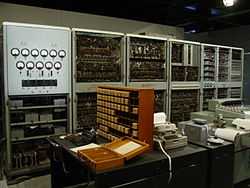Curtis Roads
Curtis Roads is a composer of electronic and electroacoustic music specializing in granular and pulsar synthesis, an author, and a computer programmer.
He studied composition at the California Institute of the Arts and the University of California, San Diego and is Chair of the Department of Media Arts and Technology at the University of California, Santa Barbara.[1] He has previously taught at the University of Naples[1] "Federico II", Harvard University,[1] Oberlin Conservatory, Les Ateliers UPIC (now CCMIX, Center for the Composition of Music Iannis Xenakis),[1] and the University of Paris[1] VIII.
He co-founded the International Computer Music Association in 1980 and edited the Computer Music Journal from 1978–2000.[1] He has created software including PulsarGenerator and the Creatovox, both with Alberto de Campo.
Roads is the first person to implement granular sound processing in the digital domain.
Since 2004, he has been researching a new method of sound analysis called atomic decompositions, sponsored by the National Science Foundation.[1]
The first movement of his composition Clang-Tint, "Purity", uses intervals from the Bohlen–Pierce scale.[2]
Publications
- Roads, Curtis (2009). Composing Electronic Music. Oxford University Press. (forthcoming)
- Roads, Curtis (2001). Microsound. Cambridge: MIT Press. ISBN 0-262-18215-7
- Roads, Curtis (1996). The Computer Music Tutorial. MIT Press. ISBN 0-262-68082-3
- Roads, Curtis (1997). Musical Signal Processing. Routledge. ISBN 90-265-1483-2
- Roads, Curtis and Strawn, John, eds (1987). Foundations of Computer Music. MIT Press. ISBN 0-262-68051-3
Compositions
- POINT LINE CLOUD (2005) @Asphodel (Excerpt @ youtube)
- Half-life (1998–1999)
- Clang-Tint (1991–1994)
References
External links
- Wired.com article by Eliot Van Buskirk Hear Curtis Roads’ Subatomic Pop Symphonies (May 5 2008), accessed 16 February 2010
- moderecords.com profile
- Asphodel artist page
| ||||||||||||||||||||||||
|
